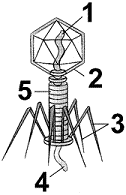An ecosystem is defined as
A. the set of environmental resources that each organism requires for survival, growth, reproduction, etc.
B. the sum of living organisms and nonliving environmental components in an area.
C. the physical place and environmental surroundings in which individual organisms live.
D. all of the members of all of the species living in an area.
E. all of the individuals of the same species living in an area.
B. the sum of living organisms and nonliving environmental components in an area.
You might also like to view...
If an organism has two copies of each chromosome, it is
A. aneuploidy. B. diploid. C. haploid. D. tetraploid. E. polyploidy.
Dermal tissue in plants
_____ is several cell layers thick. _____ acts a barrier to potential pathogens. _____ protects the plant from UV damage. _____ houses guard cells that defend against pathogen invasion. _____ differs depending if it above ground or below ground.
The structure of the virus in Figure 24-1 that is common to all viruses is:

a. 1.
b. 2.
c. 3.
d. 4.
e. 5.
A housefly can transmit diseases as a (biological/fomite/mechanical) vector
What will be an ideal response?